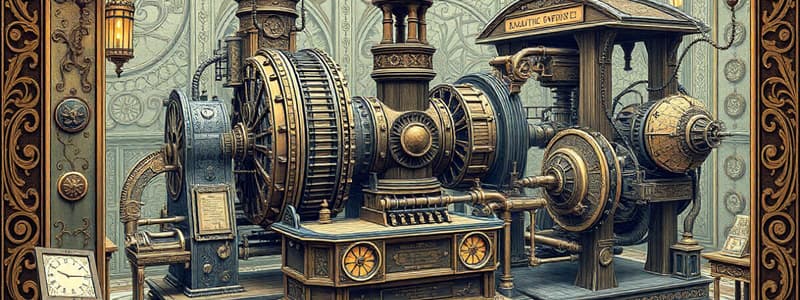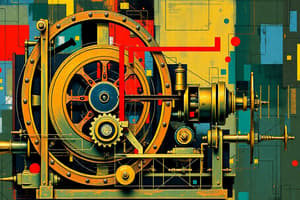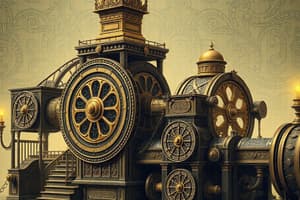Podcast
Questions and Answers
How did the Analytical Engine utilize branching, and what implication did this have for its potential functionality?
How did the Analytical Engine utilize branching, and what implication did this have for its potential functionality?
- Via a mechanical feedback loop that allowed the machine to correct errors in its calculations in real-time, thus optimizing the accuracy of iterative computations.
- By enabling the selection of alternative actions contingent on the outcome of prior operations (lateral branching), enhancing its ability to solve diverse problems. (correct)
- By using a series of gears that could physically redirect the flow of calculations, allowing it to physically alter its processing path based on intermediate results.
- Through a complex system of levers and pulleys that adjusted the machine's parameters based on predefined rules, which streamlined the processing.
What was the relationship between Ada Lovelace and Charles Babbage concerning the Analytical Engine?
What was the relationship between Ada Lovelace and Charles Babbage concerning the Analytical Engine?
- Lovelace independently conceived the idea for the Analytical Engine, while Babbage provided the mechanical expertise to design and attempt to build it.
- Lovelace promoted Babbage's ideas through translations and elaborations, because Babbage himself did not publish much about its potential. (correct)
- Lovelace and Babbage jointly developed the theoretical framework and practical designs for the Analytical Engine, co-authoring several papers on its capabilities.
- Lovelace funded Babbage's research and development of the Analytical Engine, ensuring Babbage had a means to continue.
What fundamental concept, integral to modern computing, underpinned the Analytical Engine's design, setting it apart from earlier calculating devices?
What fundamental concept, integral to modern computing, underpinned the Analytical Engine's design, setting it apart from earlier calculating devices?
- Its capacity to use conditional statements based on the results of prior computations to modify the sequence of operations, similar to branching in modern programming.
- Its reliance on a binary system of digits to perform calculations, enabling more efficient data representation and manipulation.
- Its ability to execute parallel processing of multiple tasks simultaneously, which significantly improved speed and efficiency.
- Its programmable architecture featuring a 'store' for holding intermediate results and a 'mill' for arithmetic processing. (correct)
Beyond his work on calculating machines, what broader impact did Babbage have on the development of industrial practices and economic thought?
Beyond his work on calculating machines, what broader impact did Babbage have on the development of industrial practices and economic thought?
How did the punch cards used in the Analytical Engine control the machine's operations, and from where did Babbage draw inspiration for this?
How did the punch cards used in the Analytical Engine control the machine's operations, and from where did Babbage draw inspiration for this?
Although the Analytical Engine was not fully realized in Babbage's time, what key capabilities did its design encompass that foreshadowed features of modern computers?
Although the Analytical Engine was not fully realized in Babbage's time, what key capabilities did its design encompass that foreshadowed features of modern computers?
What distinguishes the Analytical Engine's design from that of Babbage's earlier Difference Engine in terms of computational versatility?
What distinguishes the Analytical Engine's design from that of Babbage's earlier Difference Engine in terms of computational versatility?
Given his diverse intellectual pursuits, how did Babbage's broader interests beyond computation influence his work on the Analytical Engine and his view of its societal potential?
Given his diverse intellectual pursuits, how did Babbage's broader interests beyond computation influence his work on the Analytical Engine and his view of its societal potential?
What were the primary limitations that prevented the Analytical Engine from being fully constructed and utilized during Babbage's lifetime?
What were the primary limitations that prevented the Analytical Engine from being fully constructed and utilized during Babbage's lifetime?
What evidence suggests that Babbage's contemporaries recognized the significance of his work on the Analytical Engine, even though it was never fully completed?
What evidence suggests that Babbage's contemporaries recognized the significance of his work on the Analytical Engine, even though it was never fully completed?
Flashcards
Analytical Engine
Analytical Engine
A proposed mechanical general-purpose computer designed by Charles Babbage, featuring a store and a mill.
"Store"
"Store"
A location to temporarily hold intermediate calculation results.
"Mill"
"Mill"
The arithmetic processing unit in the Analytical Engine.
Looping/Iteration
Looping/Iteration
Signup and view all the flashcards
Lateral Branching
Lateral Branching
Signup and view all the flashcards
Babbage Principle
Babbage Principle
Signup and view all the flashcards
Mechanization
Mechanization
Signup and view all the flashcards
Streamlined division of labor
Streamlined division of labor
Signup and view all the flashcards
Study Notes
- Babbage devoted years to the realization of a gigantic idea in 1842, according to Luigi Menabrea.
Analytical Engine
- The Analytical Engine was programmed to add and divide using punch cards held by strings.
- Babbage copied the punch card idea from French weaver Joseph Jacquard, who used them to control patterns on looms.
- The design for the Analytical Engine had a similar logical structure to modern computers.
- The Analytical Engine featured a "store" for holding intermediate results and a "mill" for arithmetic processing.
- It could repeat an operation a specified number of times (looping/iteration).
- Depending on the result of an operation, it could choose alternative actions (lateral branching).
- The Analytical Engine could print results on paper or as a "stereotype" impressed on plaster of Paris to form a mold for a printing plate.
- Although never built, the Analytical Engine represented a crucial development from the basic arithmetical processing of the Difference Engine and is considered the forerunner of the modern computer.
- Babbage did not publish much about the Analytical Engine's potential.
- Ada Lovelace translated a paper about the Engine in 1842, and Babbage asked her to expand upon it to help others understand.
Babbage's Talents
- Babbage was a true polymath, having written more than 80 scientific papers.
- His papers covered topics from solar eclipses to geology and statistics, and from decimalization to diving bells and lighthouses.
- He designed a prototype ophthalmoscope for looking at the retina of the eye.
- He designed a "cowcatcher," a metal frame at the front of trains to clear railroad tracks.
- Babbage's ideas on mechanization went further than just calculating machines.
- Inspired by error-free efficiency, he made proposals related to human productivity.
- In 1832, he wrote On the Economy of Machinery and Manufactures, suggesting industrial manufacturing should be improved by mechanization.
- Babbage proposed a more streamlined division of labor, an idea now known as the Babbage principle.
Studying That Suits You
Use AI to generate personalized quizzes and flashcards to suit your learning preferences.




